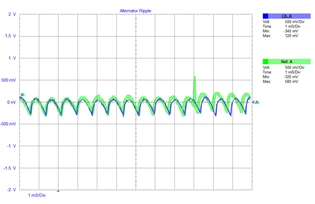Answer
Nov 26, 2012 - 04:54 PM
You do not need an AC input filter. The LS-2000 and the ADL-7100 have both DC and AC input coupling.
To setup for AC input:
Locate the MAIN MENU located at the top of the right margin of the screen. Press the button to select the appropriate channel. Select AC
Here are some notes from Jorge:
Jorge (aeswave.com) says, "Think of the ac filter as only displaying the 'always changing' portion of a signal". In other words, the AC filter eliminates the steady DC component of the signal.
For example, if you connect your scope to read the output of a battery/charging system. On DC input coupling the signal is a straight line representing the actual DC voltage.
When using an AC filter, the scope will display 0 volts - the steady voltage will be eliminated. It is kind of like a vacuum advance diaphragm with a big leak!
Why use an AC filter (or AC input coupling):
A common use of an AC filter is to see the minor fluctuations in a signal. For example the alternator diode humps when charging. The fluctuations of voltage drop on a battery when cranking.
By using the AC input coupling, the DC portion of the signal is removed and a low volt per division setting can be used to focus in on the minor fluctuations.
Start with these setting for alternator diodes: Voltage - 500mv/Div Time - 1mS/Div
Here are some more notes from Jorge (aeswave.com)
Note 1: AC wheel speed sensor Some automotive signals are called AC such as an AC wheel speed sensor. It is not necessary to use an AC filter to view these signals. In fact, for some automotive AC sensor signals it is a must to not use AC input coupling because some of the signals are riding on a small DC voltage. Proper signal analysis has to include the DC voltage. The DC voltage is one method of the PCM to determine if the wheel speed sensor circuit is 'open'.
Note 2: AC Line Voltage The AC filter is not intended to be used with AC line voltage - wall socket type voltages! In fact, it is not recommended for any automotive scope to be connected to line voltage.
Alternator Diode Example and setting
Source:







Add New Comment